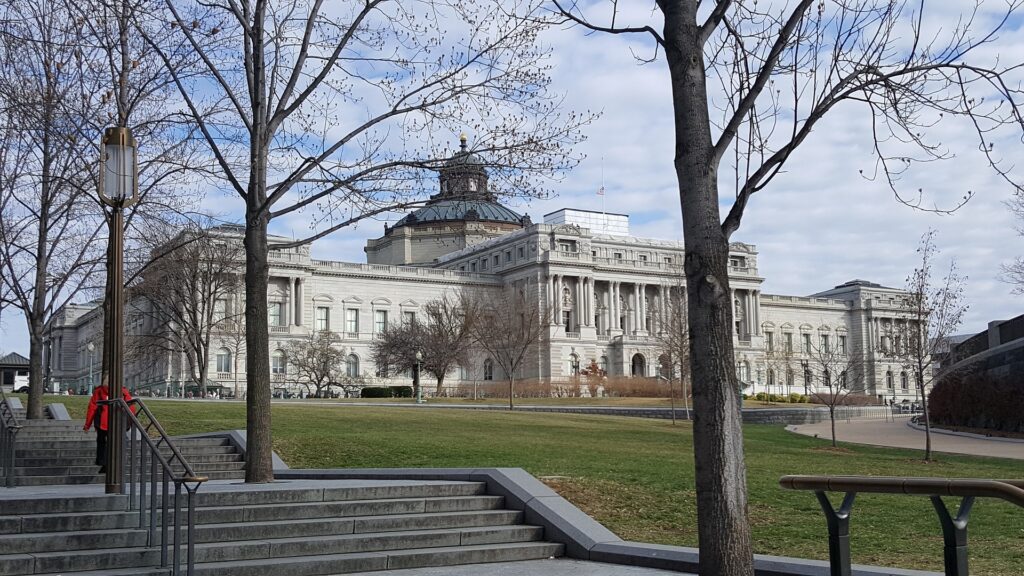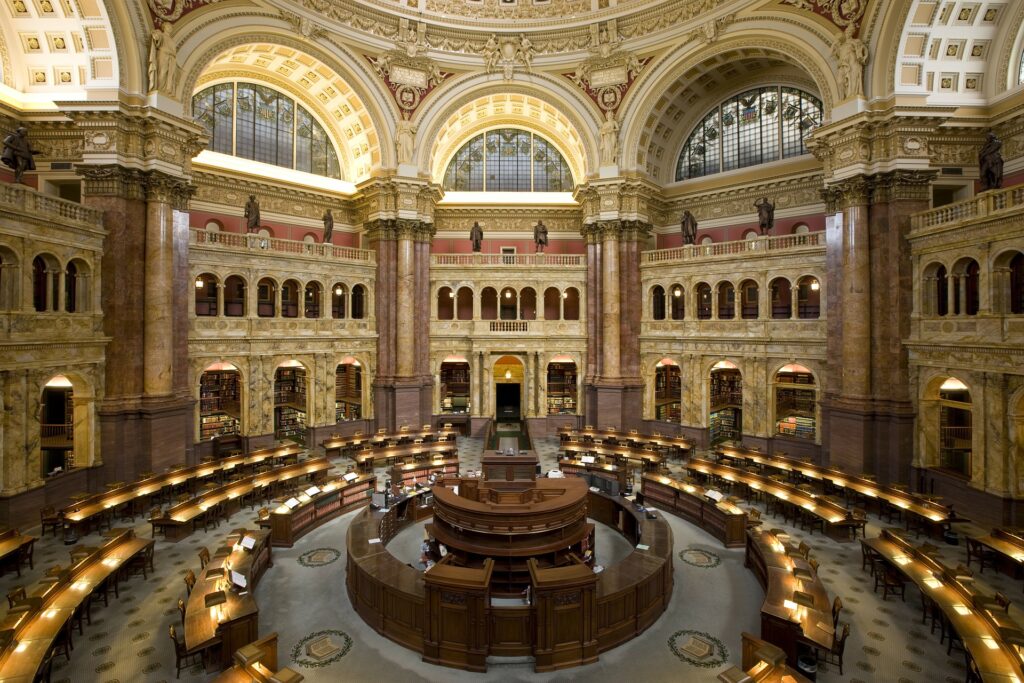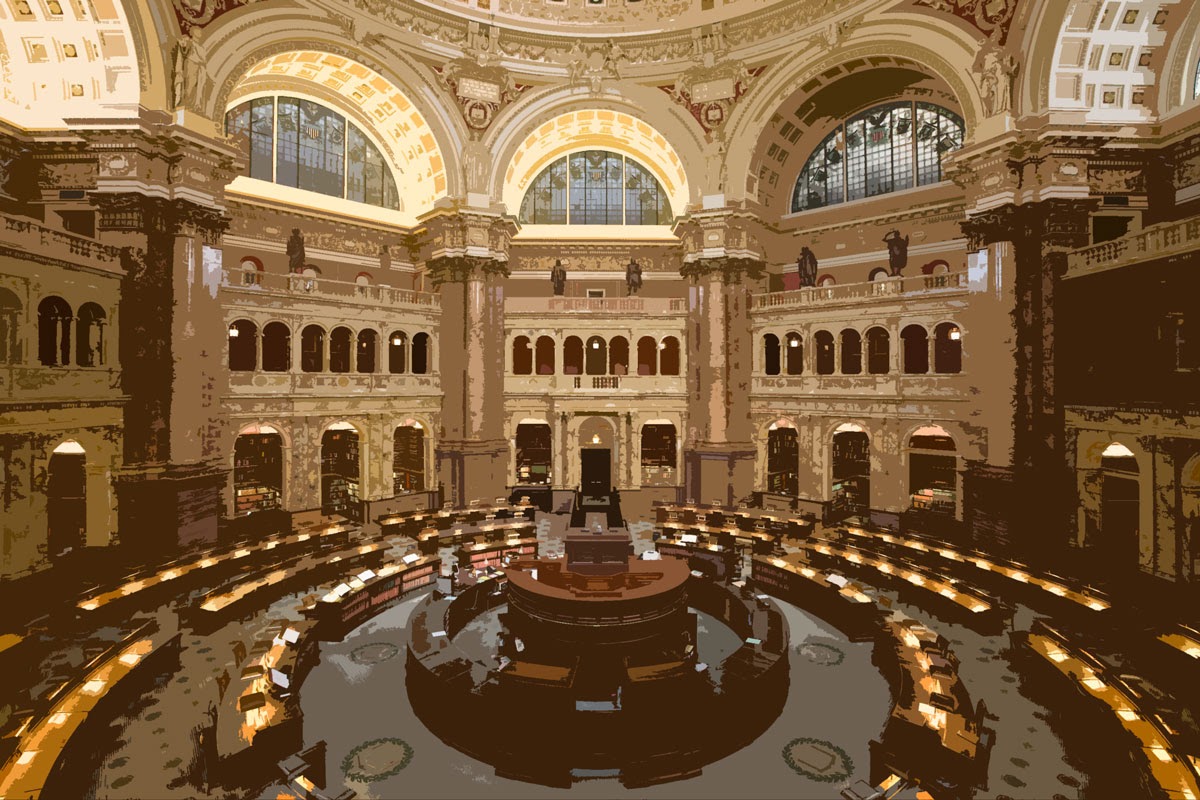By Jason Epperson
Listen Below:
America is home to lots of things that we get to claim are the biggest and greatest, but there’s one facility in the U.S. that probably deserves more bragging rights than any other, and it’s not one that’s often talked about. It’s the biggest library in the world, and It also just happens to be one incredible display of American architecture – The Library of Congress.

The Library of Congress:
I think one of the biggest mistakes people make when putting Washington D.C. on their travel itineraries is not giving it enough time. I know we were guilty on our first visit. We had about 36 hours, which was just enough time to walk by the Washington monument, go to the White House visitor center, walk to the Lincoln Memorial, and visit just one of the 17 Smithsonian museums. There’s so much to do in D.C., you could spend a month and not see it all. There’s the National Archives where the Constitution, Bill of Rights, and Declaration of Independence are stored. There’s the Capitol building, the Jefferson Memorial, the various war memorials—heart-stopping each. Ford’s Theater, the Tidal Basin and Cherry Blossoms, the National Cathedral, the Kennedy center… and so much of it is free and wonderful. D.C. is more than just a place where we remember and reflect on the great and difficult of American history, it’s where the world meets, and it’s where we hold centuries of knowledge and discovery. The amount of information and artifacts contained within the Smithsonian and the National Archives alone are mind-boggling, but they pale in comparison to the information stored at the Library of Congress.
The Library of Congress began in 1800 with a small appropriation to buy reference books within the Capitol building. Unlike Philadelphia or New York where Congress had previously met, there were no libraries in the infant city of Washington so one was created out of necessity. To replenish the collection that was destroyed by the British when they burned the Capitol building during the War of 1812, Congress purchased Thomas Jefferson’s 6,487 volume library. From that time the congressional library has steadily grown into what is today the largest in the world, with more than 170 million items.
When the U.S. established rules for copyright registration, a stroke of genius required two copies of each work to be sent to the Library of Congress. Now, the Library receives some 15,000 items each and every day.
Since 1962, the Library of Congress has maintained offices abroad to acquire, catalog, and preserve library and research materials, including New Delhi, Cairo, Rio de Janeiro, Jakarta, Nairobi, and Islamabad. Approximately half of the Library’s book and serial collections are in languages other than English, including the largest assemblage of Chinese, Japanese and Korean materials outside of Asia, The largest collection of Russian-language materials outside of Russia, and the largest Latin-American collection in the world.
It’s the largest law library, the largest rare-book collection, and even has one of the largest books in the world: it’s 5-by-7 foot featuring color images of Bhutan created by a team of students from MIT.
The oldest written material in the Library is a cuneiform tablet dating from 2040 B.C. There’s one of the three perfect vellum prints of the Gutenberg Bible. There are the papers of 23 presidents, including George Washington. More than 17 million visual images, including the most comprehensive international collection of posters in the world, and the most comprehensive visual record of the Civil War.
There are more than 3.6 million sound recordings and more than 1.8 million film, television, and video items, representing more than a century of audiovisual production. And, of course, the most comprehensive collection of American music in the world, with more than 22 million items.
The library’s American Folklife Center is the largest repository of traditional cultural documentation in the United States, containing the largest collection of American Indian music and spoken word. The center also administers the Veterans History Project, which was established by Congress in 2000 to preserve the reminiscences of the nation’s war veterans. To date, more than 100,000 submissions have been collected, including many from members of Congress.
The Library’s Geography and Map Division holds more than 5.6 million items…you guessed it, the world’s largest. The collection includes a 1507 world map—the first document on which the name “America” appears.
There are more than 124,000 telephone books, 140,000 comic books, the country’s largest collections of technical reports and standards.
The library of congress is truly one of America’s greatest accomplishments. If you’re on vacation to D.C. it’s a sight to see, just for the shear size, but it’s also no slouch in the architecture department.
History of The Library of Congress:
THOMAS JEFFERSON BUILDING:
Before the Capitol building was burned, the Library was already outgrowing its digs. There was never space enough to shelve the collections properly and it was decided upon reconstruction of the Capitol to move the library into its own building, which would be named after the Library’s patron, Thomas Jefferson. The grand design of the Thomas Jefferson Building was based on the Paris Opera House and was aimed at proclaiming America’s faith in learning and knowledge as vital strengths in upholding the republic.
With its synthesis of architecture, art, decoration, and ambition, the Library of Congress’s Jefferson Building ranks among America’s greatest achievements. When it opened November 1, 1897, writers could not find enough ways to herald the new day they saw for American civilization. The grandeur of the building, its size and scope, the noble artwork, and fascinating sculpture left many Americans breathless. Many saw the new building as the fulfillment of American intellectual promise and the perfection of American art. One said that it was “likely to long remain unrivaled in this or any other country,” while another said, “Not until I stand before the judgment seat of God do I ever expect to see this building transcended.”
In the late 19th century the architectural style of the Jefferson Building was said to be “Italian Renaissance.” Today, it is recognized as a premier example of the Beaux-Arts style, which is theatrical, heavily ornamented, and kinetic. It is a style perfectly suited to a young, wealthy, and imperialistic nation in its Gilded Age. The materials — 15 varieties of marble, 400,000 cubic feet of granite, bronze, gold, and mahogany — were expensive but would last a thousand years. The building was is a hollow rectangle with a massive rotunda reading room, book stacks, and four courtyards occupying the core. Two of the courtyards have been filled with additional book stacks while another was partially filled with a recital hall.
The front faces the Capitol Building, rising four stories above grade with a low dome covering the central reading room. A split stair featuring the Neptune Fountain rises multiple flights to the main entrance, with three pairs of sculpted bronze doors. The granite exterior is heavy and rustic at the lowest level but grows finer and smoother as the walls rise. Paired Corinthian columns flank the central portico, which has busts of famous writers framed by circular windows. A gold-leafed “flame of knowledge” tops off the dome.
JOHN ADAMS BUILDING
As large and immaculate as the Jefferson building was, the collection quickly outgrew it, and more space was required.
In 1928 the Librarian of Congress, Herbert Putnam, urged the authorization of an annex to relieve the potential space shortage that was sure to affect the 31-year-old main building. Despite stack space that was added in 1910 and 1927, the prospect of running out of room in the near future was real.
$6,500,000 was appropriated to build the annex, along with a tunnel to connect it to the main building.
Architect of the Capitol David Lynn commissioned the Washington architectural firm of Pierson & Wilson to design it, with Alexander Buel Trowbridge as a consulting architect. The contract stipulated completion by June 24, 1938, but the building was not ready for occupancy until December 2. It opened its doors to the public on January 3, 1939.
It was known simply as “The Annex” before being named for President John Adams.
The John Adams Building is a well detailed but restrained Art Deco design, the style was inspired by a decorative arts exposition in 1925 Paris. The building rises five stories above ground, with the fifth set back 35 feet. It contains 180 miles of shelving (compared to 104 miles in the Jefferson Building) and can hold ten million volumes. There are 12 tiers of stacks, extending from the cellar to the fourth floor. Each tier provides about 13 acres of shelf space. Surrounding the central book stack core are three floors of offices with access to natural light and air.
The exterior is faced with white Georgia marble, with subtle carved decoration. The bronze and glass doors feature the history of the written word depicted in twelve figures.
The building’s interior showcased new modern materials such as acoustical block, Formica, and glass tubing. Decorative features and metalwork exemplify Art Deco’s streamline classicism.
When the Adams building opened in 1939, the Library’s shelving capacity tripled to 15 million volumes. A pneumatic tube system whisked books in leather pouches from the annex to the main reading room across the street in just 28 seconds.
JAMES MADISON MEMORIAL BUILDING
In 1957, another Librarian of Congress, Quincy Mumford, initiated studies for a third library building to ease overcrowding. Congress appropriated planning funds for that structure in 1960. In an unrelated move that same year, Congress established a commission to create a national memorial for James Madison, Father of the Constitution and fourth President of the United States. Soon the goals of both ventures were merged when it was decided to construct the latest library building as a memorial to Madison.
Construction of the James Madison Memorial Building of the Library of Congress was approved on October 19, 1965, at a cost of $75 million. Excavation and foundation work began in June of 1971, and work on the superstructure was completed in 1976. The cornerstone was laid on March 8, 1974. The building finally opened on May 28, 1980.
The Madison Building was designed by the firm of DeWitt, Poor & Shelton, which had previously designed the east extension of the Capitol that was built from1958 to 1962. With its tall, plain columns, the design attempted to capture the spirit of classical architecture while remaining faithful to modern innovation. Critics have generally not been impressed, and usually deride the building as a cold, graceless, hard-edged box. That’s fine because it’s absolutely massive. The Madison building t is 500 feet wide and 400 feet deep containing 2,100,000 square feet. It is one of the three largest public buildings in the Washington area, along with the Pentagon and F.B.I. Building.

Visiting the Library of Congress:
With so much space at the Library of Congress, you can give a lot of time to it. There are lots of different tour options, but most will just walk the halls of the Jefferson building for themselves, or Take a free one-hour walking tour of this historic building and learn about its history, symbolic art, and architecture.
It’s not just a collection of information, it’s interpreted for you in rotating displays and exhibitions, and there are tons of free events to take part in. And, of course, you can get yourself a library card, explore the collections, research, listen, watch, and read.
As is the custom at several of the D.C. sights, visitors entering the Library’s buildings must go through airport-like security. Leave your razors, pocket knives, and suitcases behind.
Connect and Subscribe:
To learn more about the RV Miles Network, including the RV Miles and America’s National Parks Podcasts, visit RVMiles.com.
You can hear this story and more on the See America Podcast. Available on Apple Podcasts or wherever you listen to podcasts.
Want to chat about great travel destinations all across the US? Join the See America Facebook Group and don’t forget to follow See America on Instagram, Facebook, and YouTube.

See America is sponsored by Roadtrippers. America’s #1 trip planning app. Enjoy 20% off your first year of Roadtrippers PLUS with the code RVMILES2X.







